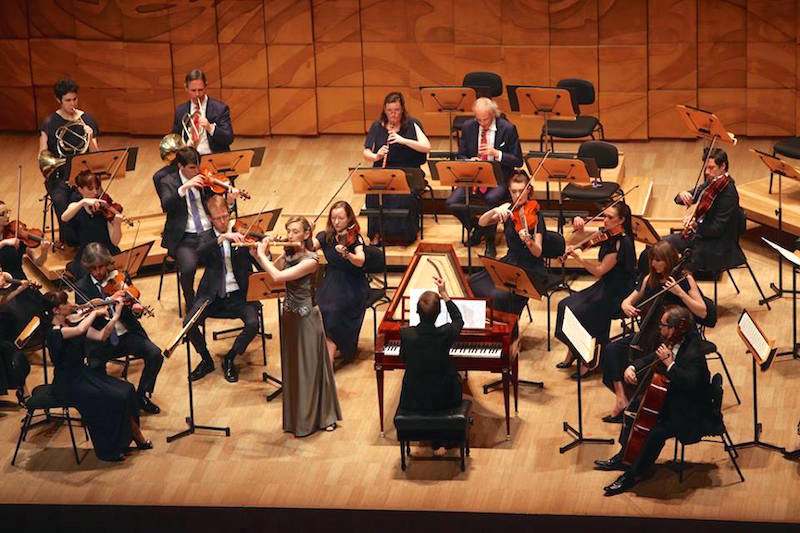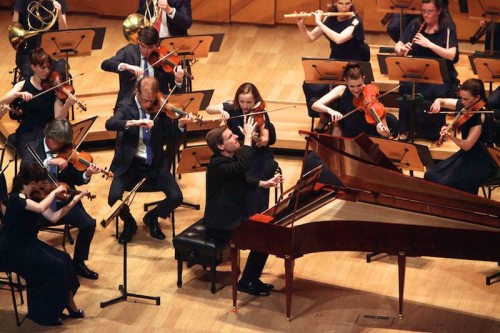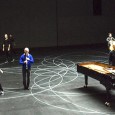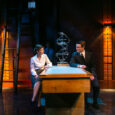Mozart’s Fortepiano, the Australian Brandenburg Orchestra’s fourth subscription series concert of 2015, sees the early music ensemble venture beyond the baroque and into the classical repertoire. Beginning with works by JC Bach and WF Bach, sons of Johann Sebastian Bach, and then featuring three compositions by Mozart – the undisputed king of the classical era – the program bridges the late baroque and early classical eras. For this concert series, the orchestra is guest directed by South African-born Fortepianist, Kristian Bezuidenhout.
The concert opened with a Sinfonia by Johann Christian Bach, the youngest son of JS Bach. The virtuosic fast movements were played with excellent rhythmic precision, and the long phrases of the slow movement were well-sustained by the string players. Given the over-articulation and micro-phrasing present in so much early music performance, it is refreshing to hear a period-instrument ensemble playing long, legato phrases.
The Sinfonia in D minor for two flutes and string orchestra by Wilhelm Friedemann Bach, JS Bach’s eldest son, begins with a slow Adagio movement and finishes with an energetic Fugue. The work is hardly a showcase of virtuosic flute playing, but Brandenburg’s flautists Melissa Farrow’s and Mikaela Oberg’s stylistic and sensitive playing were on display in the slow movement.
Guest director Kristian Bezuidenhout was soloist in Mozart’s piano concerto No. 20 in D minor. He performed the concerto on fortepiano, the eighteenth-century predecessor to the piano, which is much smaller and more lightly constructed than a modern grand piano.
Bezuidenhout played with absolute control, demonstrating his virtuosity and light touch on the keyboard to the very appreciative audience. To modern ears, however, it must be said that the piano playing was, at times, disappointingly soft. How an 18th Century instrument, designed for salons and small performance spaces, can project sufficiently in a 21st Century concert hall is a question that period-instrument ensembles undoubtedly grapple with.
The second half of the concert began with Mozart’s single movement Andante in C Major for flute, with Brandenburg’s principal flautist, Melissa Farrow, as soloist. Farrow’s elegant playing was well supported by the orchestra’s string section – the only frustration being an unembarrassed coughing episode from an audience member throughout the cadenza.
The final work in the program was Mozart’s Symphony No. 36 in C Major, the so-called “Linz” symphony that Mozart composed on a spur of the moment visit to the Austrian city of Linz. This was the Brandenburg at its very best: energetic playing, clear character variation between the movements, strongly driven tempo in the fast movements, and the wonderfully raw sound of the orchestra’s horns.
Guest Concertmaster, Madeleine Easton, deserves special mention as she led the orchestra superbly, and the strength and accuracy of her playing could be heard throughout the entire concert. In the final phrases of Mozart’s Linz Symphony, Bezuidenhout jumped off his piano stool in excitement, echoing the mood of the appreciative audience.
It was a fitting end to a concert of consistently high reward.
The Australian Brandenburg Orchestra are performing this program in Sydney at the City Recital Hall Angel Place on Wednesday 16, Friday 18, and Saturday 19 September.
Also at the Melbourne Recital Centre, Saturday September 12 and Sunday September 13. Book on (03) 9699 3333.






